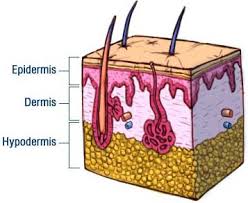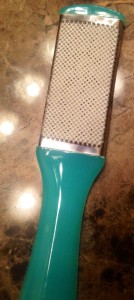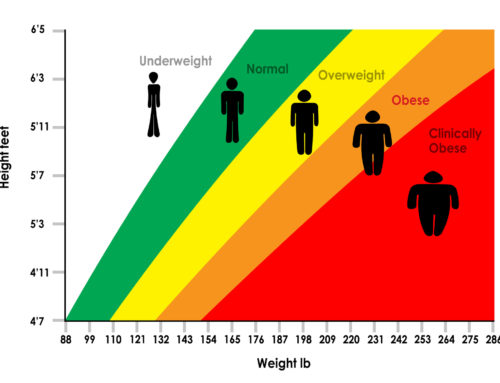I hear athletes all the time complaining about their hands. Training with a barbell, kettle bells, pull-ups, rope climbs, stones, etc. can be rough on the hands. The key to hand health is preventative maintenance and proper technique when handling equipment. A nasty rip or raw wound is no fun when you’re trying to maintain training and/or stay in the game in competition. Most importantly, an open wound at any gym no matter how clean it is, exposes you to staph and other nasty bugs that can give you a world of hurt. There are occasions though that no matter what your hand care, you’re going to rip or exceed the skins resistance to shearing loads.
The hands are designed to grasp objects and assist us in day to day tasks. To better care for the protective surface of our hands, skin, it is important to understand basic anatomy of the skin layers.
As you can see from the diagram below, skin is comprised of several protective layers. The epidermis is the most superficial layer, the dermas is the second layer and hypodermis is the third layer of skin. Each layer serves to protect the underlying tissue from foreign agents and damage.

Callused skin develops when there is repeated friction, shearing, pressure or irritation. The callus is formed by the compression and thickening of the skin layers, and the response of the skin to these pressures is to harden and protect the deeper tissues. When a callus forms, and doesn’t have adequate time to slough or is to thick due to surface tension and then has premature early forces placed upon it, it tears normally between the layer of the healthy/immature deeper skin layer and the callused skin. This then causes exposure of the non-protective more vascular layers of the skin to the outside environment and can expose you to infections. It then takes time for this layer of skin to develop and mature and for the margins of the skin wound to bridge and create a new healthy skin layer.
If you want to avoid or reduce your incidence of tearing or ripping, apply these simple hand care rules:
1. Prevent “over development” of callusing through proper grip, movement technique, and hand care
2. Develop callusing over time with proper progression of training
3. Care for calluses once they develop
4. Once a rip or wound occurs, properly care for the skin
5. Wear protective gear (grips, gloves)
1. Callusing is a normal response to friction of the skin layers. We need it to protect us and allow us to use our hands, but the use of proper grip technique and movement can reduce callusing and improve hand health. If your movement in the kipping pull-up suffers from the shoulders down, there is more friction load transferred to your grip/hands and thus more callusing. See the video below for Mark Rippetoe’s recommendations on proper grip technique.
2. The transition into full blown crossFit movements and training should be gradual and predictable. Yes, training can be constantly varied and random, but it should not be without thought and planning. If there is a workout with tremendous volume and wear on the grip, and you know your skin is already broken, beaten and scarred, scale!
3. Care for your skin should be just as important as care for your mobility, strength, etc… As a prior gymnast, I was constantly battling torn up skin. It wasn’t uncommon to have a near full thickness rip during the off season while practicing. But, the key to caring for those hands is weekly maintenance and use of a shaving and sanding tool and then adequate skin hydration. Below there is a picture of the tool I recommend and like to use.

On a weekly basis, I shave the calluses first and then fine sand the skin margins to promote a smooth yet protective surface. Here is a secret though, don’t shave the callous all the way to new un-calloused skin. Leave a thin layer of protective callous to support a tough gripping surface. Once the skin is shaved and sanded, follow with a skin lubricant such as Eucerin Aquaphor. Apply a thin layer of Aquaphor before going to bed and just let it soak in. Also, adequate water intake is key to skin and body health. Consume on a daily basis 50% of your lean mass lbs. in ounces of water. So if you have 160 lbs of lean mass, consume a minimum of 80 ounces of water.
4. If you do tear or rip, take care of the wound properly. First, hydrate and rinse the wound with clean tap water for 2-3 min, then trim excess skin if there are ragged edges or it is hanging off. If there is an intact blister with no exposed raw skin, leave it alone, and stay off your hands for a while. Once cleansed, apply a thin layer of Aquaphor and cover with a non-adherent sterile dressing. Do this every other day.
5. Wearing grips and gloves have become common place in the sport/fitness of crossFit. Don’t shy away from protective equipment if you need it. I remember when I first started crossFitting, if you wore gloves or grips you were a puss. Not anymore. Isn’t funny how once more prominent athletes adopt a particular practice all the sudden it is no longer considered taboo but accepted.
If you apply these principles, I can almost promise you, your hands won’t limit your training or slow you down! I don’t wear gloves or grips, and I have never had a rip or tear that limited my training or competition. This doesn’t mean I haven’t ripped, but proper hand care will limit the damage. I don’t personally wear gloves because I don’t like the way my grip feels, but I also prepare my hands for competition just like I would my skills, mobility, etc…
Grip it, but don’t rip it!
Coach D




Leave A Comment